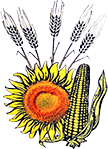ABSTRACT
The study was carried out at the Maize Research Institute “Zemun Polje”, Belgrade, Serbia during 2021 growing season in three location. Six inbred lines were crossed according to complete diallel method. In this way 15 hybrids and 15 reciprocal combinations were obtained. Hybrid and reciprocal combinations derived from these parental components were used in this paper.
The present study was carried out to study the variability, broad-sense heritability (H2bs), genetic advance (GA), correlation among traits, genotypic and phenotypic path analysis among grain yield and its components. The results indicated that the genotypes were significantly different for all traits. For all traits, the phenotypic coefficient of variation was higher than the genotypic coefficient of variation. The highest heritability was found in 1000 kernel weight, followed by grain yield, ear diameter and anthesis-silking interval (ASI). In our study Genetic Advance over Mean (GAM) for the traits ranged from lowest value (9.739%) for cob diameter to the highest value (90.579%) for anthesis-silking interval.
According to results of path analysis, the trait 1000 kernel weight with the value of 0.365 has the strongest direct positive effect on grain yield. Positive direct effects on grain yield were also observed for ear length (0.202), ear diameter (0.248) and number of rows per ear (0.076), while negative direct effects were observed for cob diameter (-0.057). The trait 1000 kernel weight had the highest indirect positive effects on grain yield via ear diameter (0.232). The cob diameter had highest negative indirect effect on grain yield via ear diameter (-0.048).
Coefficient of multiple determinations (R2) had a value of 0.428. This indicated the important role of additive gene effect in the inheritance of these traits and could be improved through simple selection.
Keywords: direct selection parameters, heritability, genetic advance, quantitative traits, maize.


